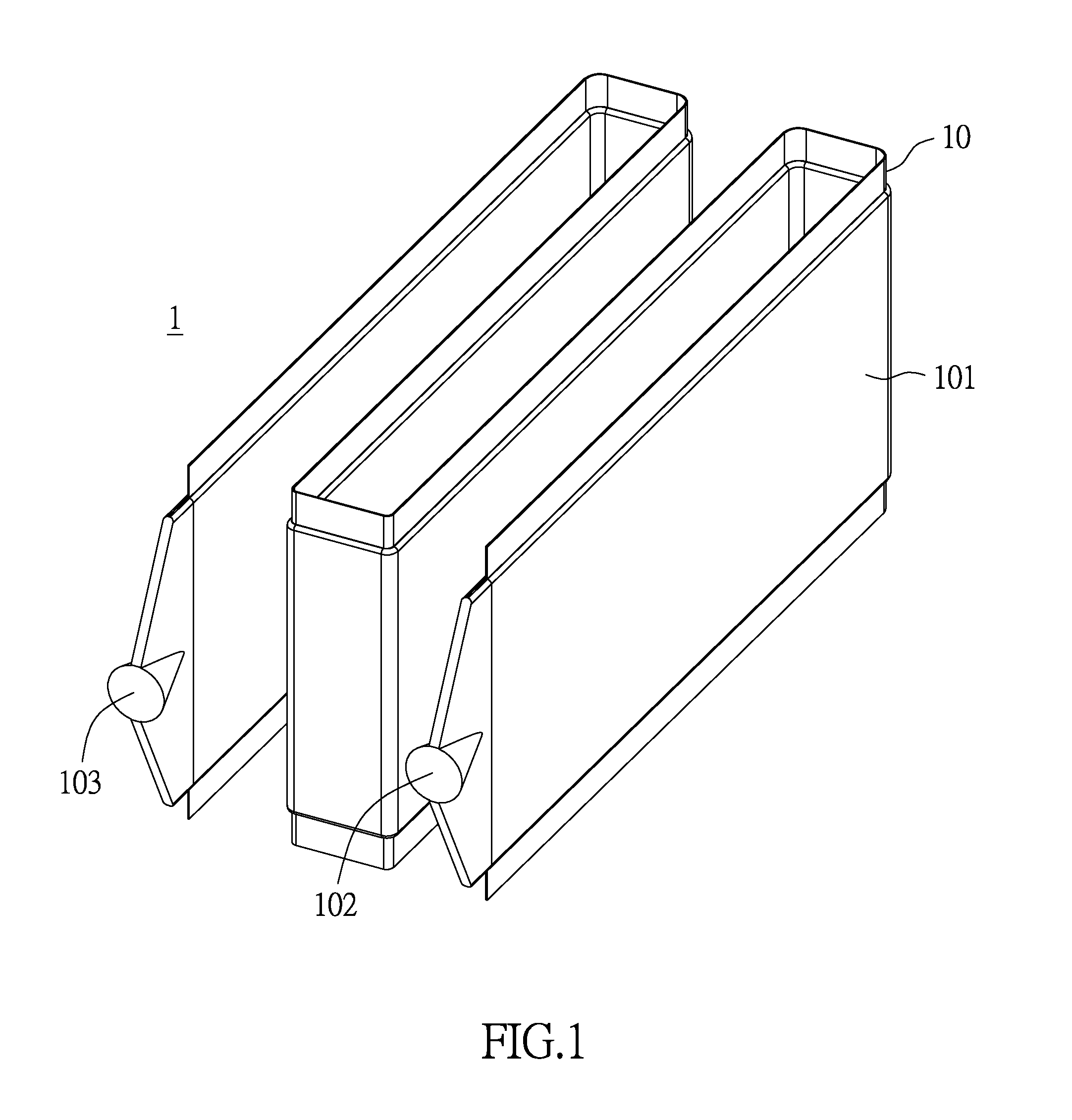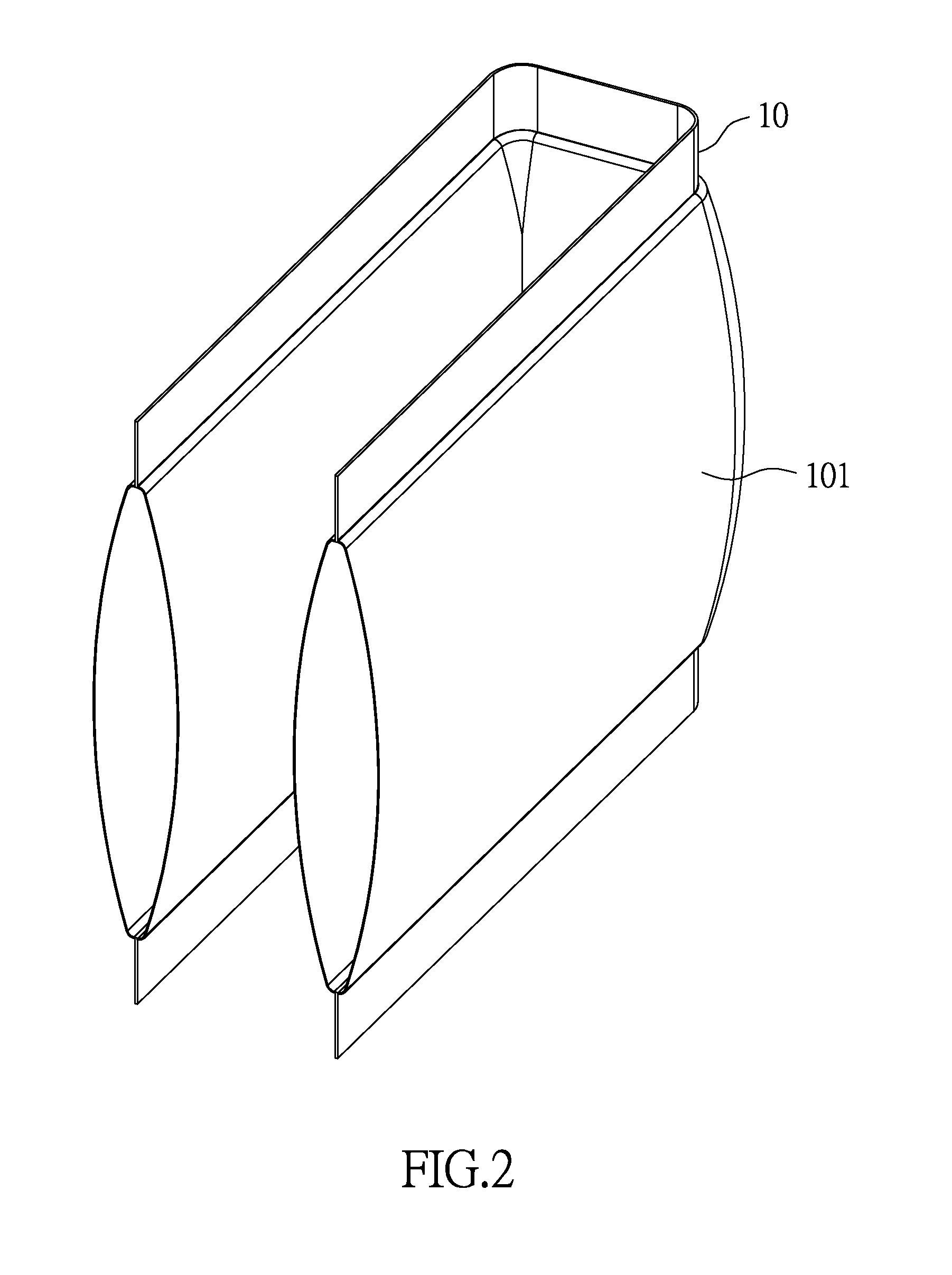Battery module and heat dissipating unit thereof
- Summary
- Abstract
- Description
- Claims
- Application Information
AI Technical Summary
Benefits of technology
Problems solved by technology
Method used
Image
Examples
first embodiment
[0032]FIG. 1 and FIG. 2 show a heat dissipating unit according to the present disclosure. As shown in the figures, the heat dissipating unit 1 includes a main body 10, which includes an expandable fluid channel 101, a fluid inlet 102 and a fluid outlet 103. The expandable fluid channel 101, the fluid inlet 102 and the fluid outlet 103 are communicated. The main body 10 can be made of a flexible material, and can be bent or wound according to the space created by the arrangement and physical shape of the battery cells. Therefore, the heat dissipating unit 1 can be applied in wide range of types of battery modules, e.g. cylindrically shaped, rectangularly shaped or soft pack batteries. In one embodiment, the main body 10 can be made of an inflexible material, and the shape of the main body 10 is chosen according to the space created by the arrangement and physical shape of the battery cells.
[0033]Specifically, in the figures of the present embodiment, the heat dissipating unit 1 is ri...
second embodiment
[0038]FIG. 5 and FIG. 6 show the aforementioned heat dissipating unit applied to a battery module. As shown in the figures, the battery module 2 includes a top cover 20, a heat dissipating unit 1, a set of battery cells 21 and a base plate 22. The heat dissipating unit 1 includes a main body 10, which includes an expandable fluid channel 101, a fluid inlet 102 and a fluid outlet 103. The expandable fluid channel 101, the fluid inlet 102 and the fluid outlet 103 are communicated. The present embodiment is not limited to what is shown in the figures of the present embodiment, and can implement features of the heat dissipating unit 1 of the previous embodiment, e.g. disposing the fluid inlet 102 and the fluid outlet 103 at any of the two ends of the main body 10, independently disposing a plurality of expandable fluid channels 101 at the heat dissipating unit 1, etc. (in the present embodiment, the fluid inlet 102 and the fluid outlet 103 are respectively disposed at two ends of the ma...
third embodiment
[0043]FIG. 7 to FIG. 9 show unitized modular heat dissipating units.
[0044]Different from the ribbon-shaped heat dissipating units 1 of the previous embodiments, the heat dissipating unit 1′ of the present embodiment is unitized and modular. As shown in FIG. 7, the main body 10′ of the heat dissipating unit 1′ can be a sheet-shaped unit structure, the expandable fluid channel 101′ can have a U-turn, and the two ends of the expandable fluid channel 101′ are respectively formed with a fluid inlet 102′ and a fluid outlet 103′. In practice, the appearance of the expandable fluid channel 101′ and the width of the same (before and after expansion) can be configured according to practical need (e.g. flow rate of the fluid) and designed accordingly without being limited to what is shown in the figures. Preferably, the expandable fluid channel 101′ is made of metal, e.g. aluminum.
[0045]Different from the previous embodiments, the heat dissipating units 1′ can be integrally formed by using fle...
PUM
 Login to View More
Login to View More Abstract
Description
Claims
Application Information
 Login to View More
Login to View More - R&D
- Intellectual Property
- Life Sciences
- Materials
- Tech Scout
- Unparalleled Data Quality
- Higher Quality Content
- 60% Fewer Hallucinations
Browse by: Latest US Patents, China's latest patents, Technical Efficacy Thesaurus, Application Domain, Technology Topic, Popular Technical Reports.
© 2025 PatSnap. All rights reserved.Legal|Privacy policy|Modern Slavery Act Transparency Statement|Sitemap|About US| Contact US: help@patsnap.com



